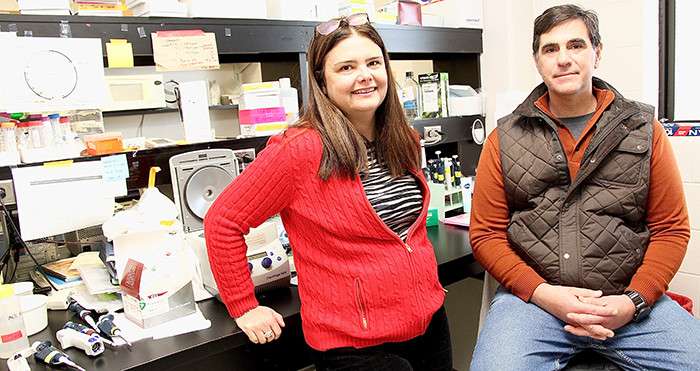Discovery adds context to Alzheimer's fight

Robarts Research Institute scientists Marco and Vania Prado will never forget the day they shared the good news with colleague John MacDonald – at a time when the former Robarts Scientific Director, and pre-eminent neurophysiologist, was in palliative care battling cancer.
One of MacDonald's research projects was investigating a particular gene, TRPM2, and its effect on stroke patients. He engaged the Prado lab to help test the gene's role, and function, in their lab's main research area, Alzheimer's disease.
Published recently in the Journal of Neuroscience, the findings of that investigation have showed this particular gene to be responsible for coding a protein linked to toxicity in Alzheimer's – meaning it may offer another important piece in solving the complex disease.
Perhaps as exciting as the findings was delivering the news to their colleague.
"We went to visit him, it was about a month before he died, and I remember quite well telling him, 'We finished the paper. We finished your idea and it works. You were right,'" Marco said. "It was the only time that day I saw his eyes sparkle a little bit. He wasn't talking much, but he said to me, 'Really? It works?' I said, 'Yes, everything went well.' That is motivation for you."
The Prados collaborated on their study with Michael Jackson, a former trainee under MacDonald and current professor at the University of Manitoba. Co-authors on the paper include postdoctoral fellow Valeriy Ostapchenko, PhD, and former graduate trainee Megan Chen, MSc'13.
The study used a Morris water maze, a spatial memory test researchers at Robarts use when studying a gene associated with a disease's pathology.
Here's how it worked: Imagine swimming in a familiar pool, but unable to find a way out of the water. The exit ladder that was always in the same corner on your previous visits has disappeared. Now, imagine this same scenario if, in addition, you had Alzheimer's disease.
Using Alzheimer's mouse models, one with the TRPM2 gene and one without, researchers placed an escape platform – like a ladder – in a small water container for a few days, aimed at memory training the mice to use it. They then removed the ladder.
The mice with the gene were confused and disoriented when trying to find a way out of the water. Those without TRPM2 remembered where the ladder was and spent a much longer time circling around where they remembered it to be.
Marco said this shows TRPM2 could be a potential therapeutic target, through medication, to assist in decreasing cognitive dysfunction in Alzheimer's because without it, while the typical plaques and aggregated proteins of Alzheimer's still exist, they are less toxic. Still collaborating with Jackson, they anticipate moving forward with the research in Manitoba.
"We didn't expect it would work so well, in terms of cognition," Marco said. "It wasn't perfect, so it didn't rescue everything, but some key things were better. The consequence of the pathology, in terms of affecting how neurons work, that was improved. It made sense for what we were expecting."
He added this latest discovery is a significant step in understanding the biology behind Alzheimer's. While scientists still don't understand how the disease develops, this finding adds another piece.
"It is a disease that is really complex. It is unlikely there is one disease called Alzheimer's – there is a spectrum – some have this type, some that have that type," Marco said. "It goes from people who have genetic mutations that will see them get Alzheimer's, to people who have some genes that may favour them getting the disease, but perhaps not as bad, to some who are neutral and very resistant.
"It's about understanding that spectrum and their complexities. Each gene is a bit different. How do they contribute to Alzheimer's? We don't know. But we are fighting. It takes one piece (of the puzzle) at a time. We are getting better at it every day."



















